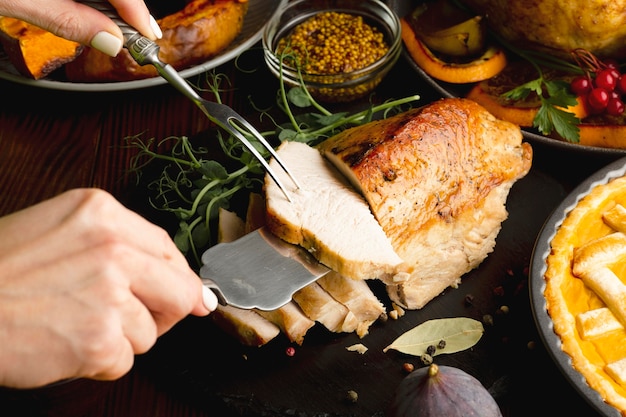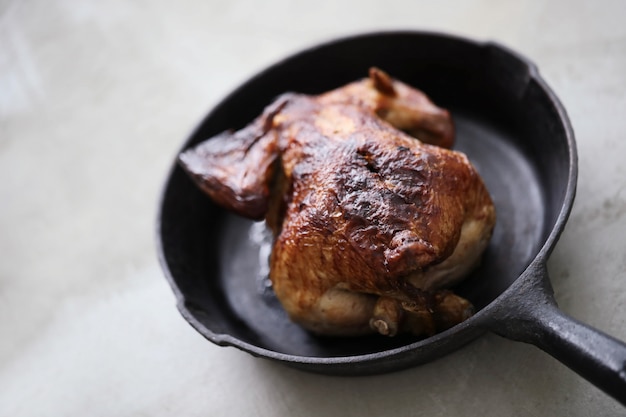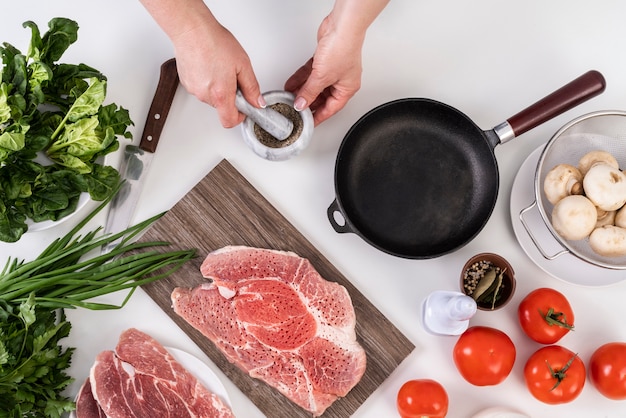(Part 1) The Pig: Choosing Your Perfect Porker

Finding Your Perfect Porker
The first step is to find your star attraction – the pig! Now, this isn't a simple trip to the supermarket. You want a genuine farm-fresh beauty, raised with care and bursting with flavour. A good butcher or a local farmer is your best bet. I've always favoured free-range pigs – they've had a good life, and it definitely shows in the taste.Understanding the Cuts
When you're talking whole pig, the thought of dealing with the entire beast might make you a little nervous. Don't worry, you don't have to be a butcher to pull this off. The butcher can help you out by breaking it down into a 'roasting joint', which is basically the back section – the loin, belly, and ribs – the perfect cut for a satisfying roast. It's also a great size for a family feast, no matter how large your crew is.Preparing Your Pig
Once you've got your pig, it's time to do a little prep work. We need to get rid of the hair, now, this is a job you can tackle yourself, with a blowtorch or a good old-fashioned scraping, but I'm not going to lie, it can be a bit messy. Personally, I usually leave this task to the butcher. It's their domain, and I'd rather leave the messy bits to the professionals.(Part 2) The Spit: Your Pig's Throne

Choosing Your Spit
Now, for the stage upon which your pig will be transformed – the spit! There are a few different types, each with their own pros and cons. You can go for a basic metal spit, which is a great budget-friendly option. Then there are electric spits, which are a bit pricier but make life a lot easier, as you don't have to manually turn the pig. Personally, I'm a big fan of the good old-fashioned manual spit. There's something special about the slow, steady turning, adding a touch of rustic charm to the whole process.Setting Up the Spit
Setting up the spit is a two-person job, so grab a friend and get ready for a bit of teamwork. Make sure the spit is securely positioned and the pig is balanced perfectly. You don't want it wobbling around like a drunken sailor!(Part 3) The Fire: Fuel for the Feast

Choosing Your Fuel
The fire is the heart and soul of your pig roast. You need something that burns hot and slow, without overwhelming the pig with smoke. I've experimented with different fuels, from wood to charcoal, but I've found that hardwood charcoal is the ultimate champion. It burns hot and long, and gives the pig a truly delicious smoky flavour.Building Your Fire
Building a roaring fire is an art form in itself, but don't worry, it's not as complicated as it seems. Start with a pile of kindling wood, then gradually add larger pieces of wood or charcoal until you've got a solid base. You want a fire that's burning hot and steady, but not too intense. We don't want to burn the pig before it's cooked!(Part 4) The Seasoning: Adding Flavour
Basic Seasoning
Now, let's talk about seasoning. You can keep it simple with just salt and pepper, but I'm a firm believer in adding a little something extra. Garlic, rosemary, thyme, and bay leaves all work beautifully with pork. Rub them all over the pig, making sure to get into all the nooks and crannies.Secret Weapon: The Brine
Want to take your pig roast to the next level? Try a brine! It's basically a salt and water solution that you soak the pig in overnight. It works magic by keeping the meat moist and tender, and it adds a whole new dimension of flavour. You can even add herbs and spices to the brine for an extra kick, giving it your own unique signature.(Part 5) The Roast: The Grand Finale
Time to Roast
Finally, it's time to get roasting! Place the pig on the spit over the fire and let it cook slowly and steadily. Turn it regularly to ensure even cooking. The roasting time will depend on the size of the pig, but expect it to take around 4-6 hours.Checking for Doneness
To check if the pig is cooked through, use a meat thermometer. Insert it into the thickest part of the meat. It should register at 71°C (160°F).The Rest: A Moment of Patience
Once the pig is cooked, remove it from the spit and let it rest for at least 30 minutes before carving. This allows the juices to redistribute and the meat to become even more tender.(Part 6) The Carving: Unveiling the Feast
Tools of the Trade
Carving a whole pig is a bit of a performance, so make sure you have the right tools. You'll need a good, sharp carving knife and a sturdy carving fork.The Art of Carving
Start by carving off the loin, which is the most tender part of the pig. Then work your way down to the belly and ribs. You can even use the bones to create a fantastic bone marrow broth!(Part 7) The Sides: A Feast for the Senses
Classic Companions
No pig roast is complete without a selection of sides. Think classic comfort foods like potato salad, coleslaw, baked beans, and corn on the cob. A big green salad is always a good idea to cut through all the richness.Global Inspiration
Don't be afraid to get creative with different cuisines! A roasted pig pairs beautifully with Mediterranean flavors like roasted vegetables, olives, and feta cheese. Or, embrace the Asian influence with a side of kimchi or a spicy noodle salad.(Part 8) The Feast: Celebrating the Pig
Gather Your Tribe
Once everything is ready, it's time to gather your friends and family for a proper feast! Set up a long table, pile on the platters, and get ready to celebrate.Sharing the Joy
The best part about a pig roast is the shared experience. It's a chance to connect with loved ones, enjoy delicious food, and create memories that will last a lifetime. Remember, it's not just about the pig, it's about the people.(Part 9) Beyond the Feast: Making the Most of the Leftovers
The Leftover Legacy
Don't let those delicious pig leftovers go to waste! There are so many ways to use them to create new dishes.Roast Pig Sandwiches
Slice up the leftover roasted pig and pile it high on crusty bread with a little bit of mustard and some crispy onions. You can't beat a good roast pig sandwich!Piggy Pasta
Shred the leftover roasted pig and add it to your favourite pasta dish. It adds a touch of richness and flavour to any pasta sauce.Piggy Pies
Make a hearty pig pie by combining the leftover roasted pig with vegetables and a rich gravy. Bake it in a pie crust for a comforting and satisfying meal.(Part 10) FAQs: Answering Your Burning Questions
1. How much pig should I get?
As a general rule of thumb, allow around 500g of pig per person. So, for a gathering of 10 people, you'll need a 5kg pig. But remember, there’s always room for leftovers, so feel free to round up if you think your guests might want seconds (or thirds)!
2. How do I know when the pig is cooked?
A meat thermometer is your best friend! Stick it into the thickest part of the meat and it should register at 71°C (160°F). However, you can also check for doneness by giving the pig a good poke. The meat should be firm and spring back when you press on it.
3. Can I use a gas BBQ instead of a fire?
Absolutely! You can roast a pig on a gas BBQ! Just make sure you have a decent-sized BBQ and enough indirect heat. You may need to experiment a bit to find the right settings for your BBQ.
4. What if I don’t have a spit?
Don't fret! You can still roast a pig without a spit! You can roast it in a large roasting pan in your oven. Just make sure you have enough space in your oven and check the cooking time carefully.
5. What are the best drinks to serve with a roast pig?
A roast pig goes great with a crisp, dry white wine or a refreshing craft beer. You can also serve a nice red wine or a strong cider. Just choose a beverage that you and your guests will enjoy.
There you have it – my complete guide to roasting a whole pig. Remember, it’s all about the experience, so don’t be afraid to experiment and have fun with it. And who knows, maybe you’ll become the next master of the pig roast!
Everyone is watching

Corn on the Cob: The Ultimate Guide to Perfectly Cooked Ears
Healthy MealsAh, corn on the cob. Just the name evokes images of sunny days, barbecues, and that sweet, juicy flavour that ...

Scallops: The Ultimate Guide to Perfect Cooking
Healthy MealsAh, scallops. Those delicate, sweet, and utterly delicious morsels of the sea. They hold a special place in my...

Spaghetti Squash: The Ultimate Guide to Cooking and Serving
Healthy MealsRemember that time you saw spaghetti squash at the supermarket, looking all bumpy and strange, and thought, "W...

Salmon Cooking Times: Perfect Guide for Every Recipe
Healthy MealsLet me tell you, cooking salmon is an art form. It's all about getting that perfect balance: juicy and tender,...

Ham Cooking Time: How Long to Bake, Smoke, or Boil a Delicious Ham
Healthy MealsAh, ham. It's a classic, isn't it? A real crowd-pleaser, especially around holidays. And when done right, it'...
